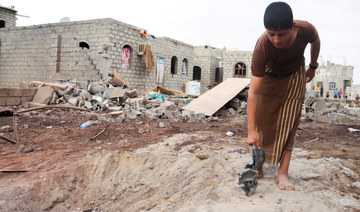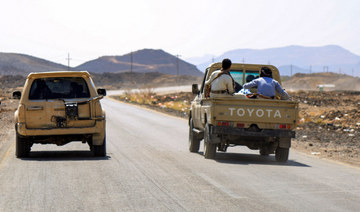AL-MUKALLA: The Arab coalition carried out a series of airstrikes on Thursday against military sites in Houthi-controlled Sanaa.
Coalition spokesperson Brig. Gen. Turki Al-Maliki said the coalition launched airstrikes on a number of military locations in Sanaa believed to host explosive-laden drones and ballistic missiles, thus “foiling deadly attacks” on civilian targets inside and outside Yemen.
Al-Maliki said the airstrikes were launched in response to Houthi attacks on Saudi airports, power stations and other public infrastructure.
“If the Houthi militia continues with its grave violations of targeting civilians, civilian objects and infrastructure, the militia should brace for broader and more comprehensive airstrikes in accordance with international humanitarian law,” Al-Maliki said in a statement.
On the ground in Yemen, fighting intensified outside the central city of Marib on Thursday, a day after the UN Security Council condemned the Iran-backed Houthi militia’s military operations in Marib province.
Residents and local military officials said fierce fighting between government forces and the Houthis in the district of Juba, south of Marib, left dozens of combatants dead as the militia stepped up its ground attacks and drone and missile strikes on government-controlled areas in the province.
The fighting began on Wednesday when the Houthis attacked government troops in Juba in an attempt to break through to the city of Marib. The Houthis were forced to cease their attacks after suffering heavy losses and failing to make any progress, according to the coalition.
Also on Thursday, the Houthis reacted angrily to the Security Council’s latest calls to cease hostilities in Marib province, end their siege of some districts and engage positively with diplomatic efforts to end the war.
The Houthis vowed to press ahead with their military operations until they control the whole of Yemen.
“Our military operations inside and outside Yemen will continue until the aggression is stopped, the siege is lifted, and foreign forces leave Yemen,” Mohammed Al-Bukhaiti, a Houthi leader, said on Twitter.
Houthi spokesman Mohammed Abdul-Salam accused the UN Security Council of bias.
“The Security Council’s adoption of the position of the aggressors is not new, and is a rude and blind bias,” Abdul-Salam said.
On Wednesday, the Security Council had slammed the Houthis for threatening international navigation in the Red Sea, mounting deadly attacks in Marib, and obstructing the provision of aid to trapped people. It urged warring factions in Yemen to comply with the UN-led peace efforts.
In a statement, the Security Council stressed “the need for de-escalation by all, including an immediate end to the Houthi escalation in Marib” and condemned “the use of sexual violence and the recruitment and use of children in conflict.” It also hailed the return of the Yemeni government to Aden and urged it to focus on stopping the devaluation of the Yemeni riyal.
“The members of the Security Council welcomed the return of the prime minister to Yemen and stressed the importance of supporting the government to deliver essential services to the Yemeni people. They expressed their strong support for the prime minister’s drive for economic reform,” a statement released after the meeting read.
Western envoys to Yemen also joined international calls for the Houthis to stop the escalation of military activities in Marib province.
During a meeting with the Yemeni Foreign Minister Ahmad Awad bin Mubarak in Riyadh, French Ambassador to Yemen Jean-Marie Safa expressed concerns about the grave impact of the Houthi’s ongoing military operations in Marib and their siege of the Abedia district, noting that his country would resist Houthi attempts to control the country by force.
However, Yemeni military officials argue that international condemnations alone may not persuade the Houthis to change course, and call for tougher punitive measures against countries and organizations that offer the Houthis military, financial or political support.
“There must be deterrent measures and pressures on this group and on the countries and organizations that support it,” Col. Abdul Basit Al-Baher, a Yemen army officer in Taiz, told Arab News.





























